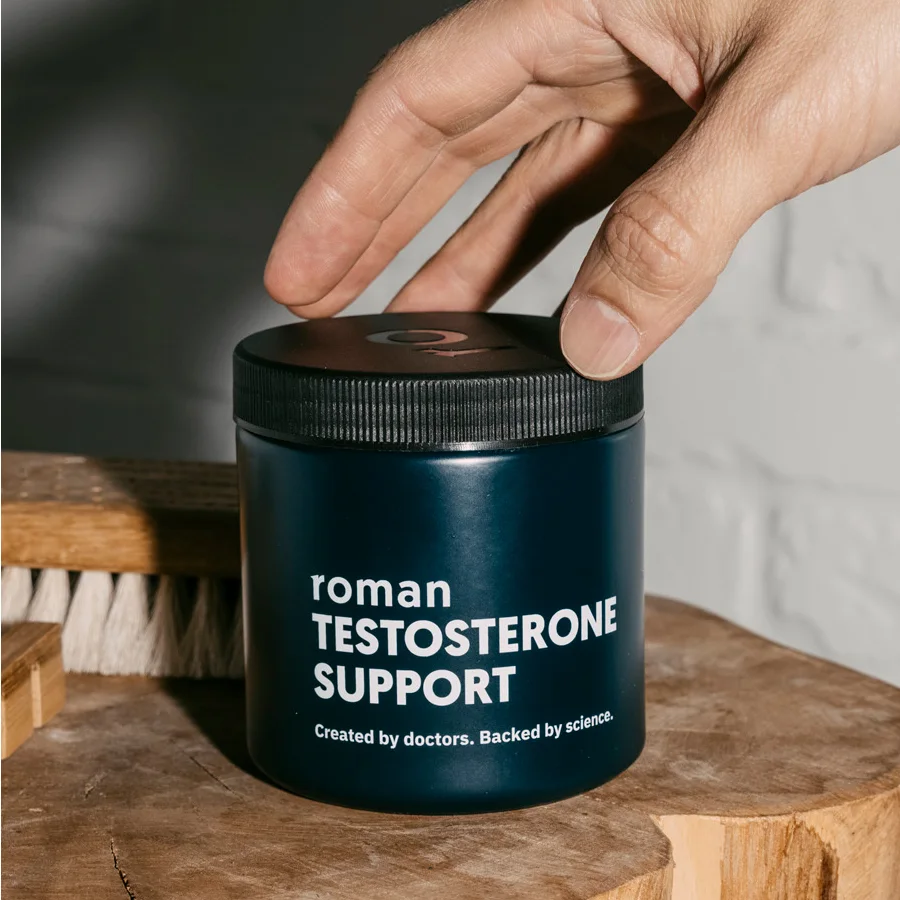Here's what we'll cover
Here's what we'll cover
Low testosterone and erectile dysfunction (ED) are two subjects of men’s health you may not want to think about, let alone be living with. Testosterone is the male sex hormone responsible for many processes in a man’s body—growing facial hair, building muscles, making sperm, libido, and yes, maybe even helping you get an erection.
If you’re living with low testosterone and you have ED, you may wonder, does low testosterone cause ED? Yes and no. It’s not as simple as you might think.
Can low testosterone cause ED?
Low testosterone, or low T, can play a role in ED, but it’s not necessarily as direct of a link as you may think. It’s often not as simple as low T = ED. Many processes are involved in getting and maintaining an erection, and testosterone levels are only one piece of that puzzle. That means that some men can have healthy erections despite testosterone levels well below the normal range, and other men have ED despite normal T levels.
Here’s why: Many things have to be working correctly for a man to get and maintain an erection. Understanding how erectile function is supposed to work can be a good place to start. Once sexual stimulation occurs, a cascade of processes begins. One way an erection can occur is when nerves in the penis send signals to the spinal cord and brain, which cause the muscles and blood vessels in the penis to relax and allow more blood in. The corpora cavernosa, tubes that run along the length of the penis, then fill with blood. This is what allows the penis to become hard.

The role of testosterone in erectile function during sex is mainly related to libido (sex drive). If a man’s testosterone levels aren’t where they should be, he may lack the sexual desire to get the erection process started. Some sexual stimulation is needed, whether it’s the thought of something sexual or seeing something sexually stimulating. Low T, though, might prevent this desire from even getting started. Without that spark, an erection isn’t happening. In other words: treating low T can improve a man's sex life by increasing libido and renewing his interest in sex.
Other factors, such as underlying medical conditions, are more likely to cause erectile dysfunction than low T. Basically, any medical condition that affects how well nerves or blood vessels work can also contribute to ED. These conditions include high blood pressure (hypertension), obesity, atherosclerosis, and diabetes. Here are some ways that medical conditions can cause ED:
Diabetes: Uncontrolled high blood sugar levels can damage blood vessels and nerves responsible for erectile function, making it difficult to achieve and maintain an erection. Damage to certain blood vessels in the testicles can also reduce testosterone production.
Hypertension: High blood pressure (hypertension) affects the way blood flows through the body, including the penis. Like diabetes, high blood pressure can also cause damage to blood vessels which contributes to erectile dysfunction over time.
Atherosclerosis: Atherosclerosis, a buildup of plaque in the arteries, can narrow the blood vessels and reduce blood flow to the penis.
Obesity: Excess body weight is linked to systemic (bodywide) inflammation, which can damage testicular tissue and interfere with testosterone production. This inflammation can also damage blood vessels in the penis, contributing to ED.
How do you know if you have low testosterone?
Testosterone is made in the testicles. Over time, it’s natural to produce less testosterone in adulthood than when you were a teenager, with T levels starting to decline in a man’s 30s. The medical term for when testosterone becomes lower than expected is called hypogonadism, and symptoms of low testosterone can include:
Low sex drive
Erectile dysfunction
Loss of facial and pubic hair
Decreased muscle mass
Depressed mood
Weight gain (usually due to increased body fat)
Difficulty concentrating
Fatigue
Decreased sperm production
Anemia (low red blood cells)
Many of the symptoms above can also be caused by other health conditions, including diabetes, obesity, and hypothyroidism.
What to do if you think low testosterone is causing ED
If you suspect you may have low T, contact your healthcare provider for medical advice. In addition to reviewing your symptoms and performing a physical exam, your healthcare provider can order blood tests to help determine your testosterone levels.
Blood testosterone tests to diagnose low testosterone (low T) are typically done in the morning on two separate days, though some of this depends on your provider’s discretion. Testosterone levels naturally fluctuate throughout the day, peaking in the morning and dropping in the afternoon and evening. By conducting two separate tests, healthcare providers can confirm whether a low testosterone reading is consistent or a temporary fluctuation and clarify borderline levels.
Normal vs. Low Testosterone Levels:
Normal testosterone levels for adult males generally range between 300 to 750 nanograms per deciliter (ng/dL), though definitions of “normal testosterone” can vary.
Low testosterone is typically diagnosed when levels fall below 300 ng/dL on two separate tests, though this can vary depending on your age.
Other hormone levels, such as luteinizing hormone, prolactin, and thyroid stimulating hormone, may also be checked to see if they are at normal levels.).These hormones play key roles in regulating testosterone production and overall hormonal balance; abnormal levels can help pinpoint the underlying cause of low T.
How to treat low testosterone
If your healthcare provider has diagnosed you with low T, you may wonder what can be done to treat it. If T levels are low, your provider may suggest testosterone replacement therapy, or TRT.
Testosterone replacement therapy
You can get TRT through a patch placed on the skin or with a gel used daily. It can also be given through intramuscular injection or through pellets which are injected and release testosterone slowly into the body.
Studies of older men with age-related testosterone loss have shown TRT may help with sexual function, bone density, anemia, muscle strength, and loss of body fat in those who were previously testosterone deficient. However, TRT must be provided by a licensed healthcare professional, with testosterone levels monitored regularly.
Prescription medication
You might have also read about a prescription drug called Clomid (generic name: clomiphene or clomiphene citrate)—an alternative to TRT. Healthcare providers can prescribe Clomid off-label for hypogonadism in men, a condition that involves low levels of sperm, testosterone, or both. Because clomiphene doesn’t dull the body’s natural testosterone production like TRT, it can maintain male fertility while gradually increasing testosterone levels. That’s why men with low testosterone who want to start a family may opt for an alternative like clomiphene.
How to treat ED
First things first: If your testosterone levels are in the normal range, raising it to higher levels is not medically recommended, and it probably won't help your ED—your libido might increase, but you still might have issues getting an erection since there could be other factors at play. Having high levels of testosterone is also not good. Taking too much testosterone, especially if it’s not given to you by an experienced provider, can lead to other health problems and side effects. These problems can include:
Acne
High red blood cell counts (which can have complications including stroke)
Blood clots
Mood swings
Also, if you have low T, normalizing testosterone levels only works for ED if low T is the main cause of your ED—and that’s pretty rare, as we’ve learned above.
The most common treatment for ED can include medications and lifestyle changes.
Prescription medications
The class of medications to treat ED are called PDE-5 inhibitors (phosphodiesterase 5 inhibitors). These medications include sildenafil (Viagra) and tadalafil (Cialis), which work by helping the muscles and blood vessels inside the penis relax so that blood can fill the penis and an erection can happen. It’s important to note that some sexual stimulation is still required to start the process.
Common PDE-5 inhibitors include:
Viagra (sildenafil)
Cialis (tadalafil)
Vardenafil (formerly available as brand-name Levitra)
Stendra (avanil)
Another option is compounded ED medications such as Ro Sparks or Daily Rise gummies. These compounded medications can sometimes work faster and be more convenient to take than traditional ED medications.
Viagra Important Safety Information: Read more about serious warnings and safety info.
Cialis Important Safety Information: Read more about serious warnings and safety info.
Penis injections
If ED meds don’t work, or someone isn’t a good candidate for them, other options are available, such as penile injections. Penile injections are an alternative treatment for ED when oral medications are ineffective or unsuitable. They involve injecting medication—such as alprostadil, papaverine, or a combination—directly into the base of the penis. These injections work by dilating the blood vessels and relaxing the muscles in the penis, helping an erection develop within 10 to 15 minutes. You usually do not need to be aroused for these medications to work.
Medical devices
Non-medication ways to treat ED include using external vacuum devices (penis pumps) that are placed over the penis, creating an air-tight seal. A vacuum pump then applies suction, which pulls blood into the penis, enlarging it and helping it get an erection. A ring is placed at the bottom of the penis to help keep the blood in.
Lifestyle changes
Healthy lifestyle habits can help manage conditions contributing to low T and support healthy hormone production. Some ideas include:
Follow a testosterone-friendly diet: Eating a balanced diet rich in healthy fats, such as fatty fish, avocados, and nuts, magnesium-rich leafy greens like spinach and kale, and foods containing zinc like meat, shellfish, eggs, and legumes, can support testosterone production.
Increase physical activity: Regular exercise, including weight training and cardiovascular (cardio) workouts, can boost testosterone levels.
Get ample shut-eye: Poor sleep reduces testosterone production. Sleeping 7-9 hours a night can help maintain healthy testosterone levels.
Maintain a healthy weight: Excess body weight can cause inflammation that damages testicular tissues, contributes to low T, and increases the risk of conditions associated with ED, such as diabetes and heart disease.
Reduce stress: Chronic stress causes the body to release high levels of cortisol, a hormone that can suppress testosterone production. Managing stress through relaxation techniques like meditation, deep breathing, or regular exercise can help improve testosterone levels.
Bottom line
Talk to your healthcare provider if you suspect you have ED, low testosterone levels, or both. Your sexual health is an essential part of your overall health. Your provider can help get to the bottom of what’s going on and develop a safe and effective treatment plan for you.
DISCLAIMER
If you have any medical questions or concerns, please talk to your healthcare provider. The articles on Health Guide are underpinned by peer-reviewed research and information drawn from medical societies and governmental agencies. However, they are not a substitute for professional medical advice, diagnosis, or treatment.
Alkhayal, A., Mahzari, M., Alhammadi, A. S., et al. (2023). Prevalence of Hypogonadism Symptoms Among Males With Hypothyroidism at a Tertiary Hospital: A Cross-Sectional Study. Cureus, 15(12), e50255. doi: 10.7759/cureus.50255. Retrieved from https://www.ncbi.nlm.nih.gov/pmc/articles/PMC10711326/
Cho, J. W. & Duffy, J. F. (2019). Sleep, Sleep Disorders, and Sexual Dysfunction. The World Journal of Men's Health, 37(3), 261–275. doi: 10.5534/wjmh.180045. Retrieved from https://www.ncbi.nlm.nih.gov/pmc/articles/PMC6704301/
de Oliveira, A. A. & Nunes, K. P. (2021). Hypertension and Erectile Dysfunction: Breaking Down the Challenges. American Journal of Hypertension, 34(2), 134–142. doi: 10.1093/ajh/hpaa143. Retrieved from https://pubmed.ncbi.nlm.nih.gov/32866225/
Fan, W., Xu, Y., Liu, Y., et al. (2018). Obesity or Overweight, a Chronic Inflammatory Status in Male Reproductive System, Leads to Mice and Human Subfertility. Frontiers in Physiology, 8, 1117. doi: 10.3389/fphys.2017.01117. Retrieved from https://www.ncbi.nlm.nih.gov/pmc/articles/PMC5758580/
Fernandez, C. J., Chacko, E. C., & Pappachan, J. M. (2019). Male Obesity-related Secondary Hypogonadism - Pathophysiology, Clinical Implications and Management. European Endocrinology, 15(2), 83–90. doi: 10.17925/EE.2019.15.2.83. Retrieved from https://pubmed.ncbi.nlm.nih.gov/31616498/
Genchi, V. A., Rossi, E., Lauriola, C., et al. (2022). Adipose Tissue Dysfunction and Obesity-Related Male Hypogonadism. International Journal of Molecular Sciences, 23(15), 8194. doi: 10.3390/ijms23158194. Retrieved from https://www.ncbi.nlm.nih.gov/pmc/articles/PMC9330735/
Gerbild, H., Larsen, C. M., Graugaard, C., et al. (2018). Physical Activity to Improve Erectile Function: A Systematic Review of Intervention Studies. Sexual Medicine, 6(2), 75–89. doi: 10.1016/j.esxm.2018.02.001. Retrieved from https://www.ncbi.nlm.nih.gov/pmc/articles/PMC5960035/
Halpern, J. A. & Brannigan, R. E. (2019). Testosterone deficiency. JAMA, 322(11), 1116-1116. doi: 10.1001/jama.2019.9290. Retrieved from https://jamanetwork.com/journals/jama/article-abstract/2749876
Harvard Health Publishing. (2019). Testosterone- what it does and doesn’t do. Retrieved from https://www.health.harvard.edu/medications/testosterone--what-it-does-and-doesnt-do
He, Z., Yin, G., Li, Q. Q., et al. (2021). Diabetes Mellitus Causes Male Reproductive Dysfunction: A Review of the Evidence and Mechanisms. In Vivo (Athens, Greece), 35(5), 2503–2511. doi: 10.21873/invivo.12531. Retrieved from https://www.ncbi.nlm.nih.gov/pmc/articles/PMC8408700/
Jung, J., Jo, H. W., Kwon, H., & Jeong, N. Y. (2014). Clinical neuroanatomy and neurotransmitter-mediated regulation of penile erection. International Neurourology Journal, 18(2), 58-62. doi: 58.10.5213/inj.2014.18.2.58. Retrieved from https://www.ncbi.nlm.nih.gov/pmc/articles/PMC4076481/
Long, L., Qiu, H., Cai, B., et al (2018). Hyperglycemia induced testicular damage in type 2 diabetes mellitus rats exhibiting microcirculation impairments associated with vascular endothelial growth factor decreased via PI3K/Akt pathway. Oncotarget, 9(4), 5321–5336. doi: 10.18632/oncotarget.23915. Retrieved from https://www.ncbi.nlm.nih.gov/pmc/articles/PMC5797052/
Lowy, M., & Ramanathan, V. (2022). Erectile dysfunction: causes, assessment and management options. Australian Prescriber, 45(5), 159–161. doi: 10.18773/austprescr.2022.051. Retrieved from https://www.ncbi.nlm.nih.gov/pmc/articles/PMC9584785/
Moon, K. H., Park, S. Y., & Kim, Y. W. (2019). Obesity and Erectile Dysfunction: From Bench to Clinical Implication. The World Journal of Men's Health, 37(2), 138–147. doi: 10.5534/wjmh.180026. Retrieved from https://www.ncbi.nlm.nih.gov/pmc/articles/PMC6479091/
Myers, C. & Smith, M. (2019). Pelvic floor muscle training improves erectile dysfunction and premature ejaculation: a systematic review. Physiotherapy, 105(2), 235–243. doi: 10.1016/j.physio.2019.01.002. Retrieved from https://pubmed.ncbi.nlm.nih.gov/30979506/
Millar, A. C., Lau, A. N., Tomlinson, G., et al. (2016). Predicting low testosterone in aging men: a systematic review. Canadian Medical Association Journal, 188(13), E321-E330. doi: 10.1503/cmaj.150262. Retrieved from https://www.cmaj.ca/content/188/13/E321.full
O'Donnell, L., Stanton, P., & de Kretser, D. M. (2017). Endocrinology of the Male Reproductive System and Spermatogenesis. Endotext. Retrieved from https://www.ncbi.nlm.nih.gov/books/NBK279031/
Park, H. J., Ahn, S. T., & Moon, D. G. (2019). Evolution of guidelines for testosterone replacement therapy. Journal of Clinical Medicine, 8(3), 410. doi: 10.3390/jcm8030410. Retrieved from https://www.mdpi.com/2077-0383/8/3/410/htm
Qaseem, A., Horwitch, C. A., Vijan, S., et al. (2020). Testosterone treatment in adult men with age-related low testosterone: a clinical guideline from the American College of Physicians. Annals of Internal Medicine, 172(2), 126-133. doi: 10.7326/M19-0882. Retrieved from https://www.acpjournals.org/doi/full/10.7326/M19-0882
Rivas, A. M., Mulkey, Z., Lado-Abeal, J., & Yarbrough, S. (2014). Diagnosing and managing low serum testosterone. Baylor University Medical Center Proceedings, 27(4), 321-324. doi: 10.1080/08998280.2014.11929145. Retrieved from https://www.tandfonline.com/doi/abs/10.1080/08998280.2014.11929145
Sooriyamoorthy, T. & Leslie, S. (2022). Erectile dysfunction. StatPearls. Retrieved on Oct. 9, 2022 from https://www.ncbi.nlm.nih.gov/books/NBK562253/
Tsujimura, A., Hiramatsu, I., Aoki, Y., et al. (2017). Atherosclerosis is associated with erectile function and lower urinary tract symptoms, especially nocturia, in middle-aged men. Prostate International, 5(2), 65–69. doi: 10.1016/j.prnil.2017.01.006. Retrieved from https://www.ncbi.nlm.nih.gov/pmc/articles/PMC5448724/
Zamir, A., Ben-Zeev, T., & Hoffman, J. R. (2021). Manipulation of Dietary Intake on Changes in Circulating Testosterone Concentrations. Nutrients, 13(10), 3375. doi: 10.3390/nu13103375. Retrieved from https://www.ncbi.nlm.nih.gov/pmc/articles/PMC8538516/
Zhu, J., Zhang, W., Ou, N., et al. (2020). Do testosterone supplements enhance response to phosphodiesterase 5 inhibitors in men with erectile dysfunction and hypogonadism: a systematic review and meta-analysis. Translational Andrology and Urology, 9(2), 591. doi: 10.21037/tau.2020.01.13. Retrieved from https://www.ncbi.nlm.nih.gov/pmc/articles/PMC7215032/
Zhu, A., Andino, J., Daignault-Newton, S., et al. (2022). What Is a Normal Testosterone Level for Young Men? Rethinking the 300 ng/dL Cutoff for Testosterone Deficiency in Men 20-44 Years Old. The Journal of Urology, 208(6), 1295–1302. doi: 10.1097/JU.0000000000002928. Retrieved from https://pubmed.ncbi.nlm.nih.gov/36282060/
Zueger, R., Annen, H., & Ehlert, U. (2023). Testosterone and cortisol responses to acute and prolonged stress during officer training school. Stress (Amsterdam, Netherlands), 26(1), 2199886. doi: 10.1080/10253890.2023.2199886. Retrieved from https://pubmed.ncbi.nlm.nih.gov/37014073/












